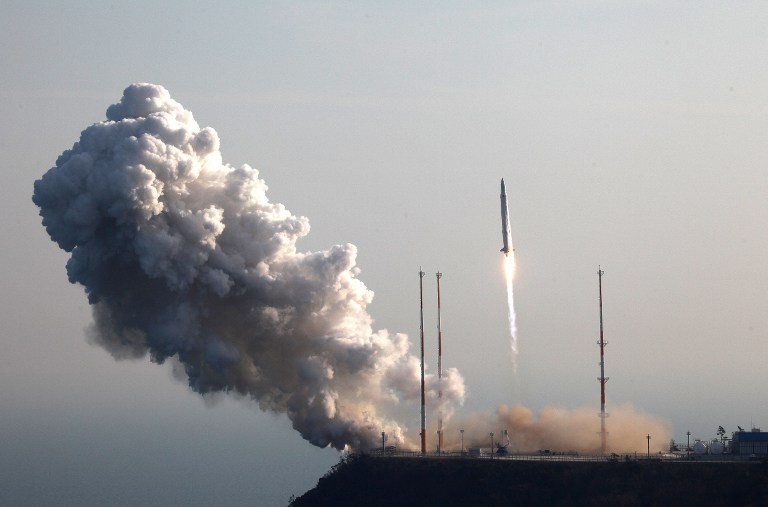SUMMARY
This is AI generated summarization, which may have errors. For context, always refer to the full article.

SEOUL, South Korea (UPDATED) – South Korea succeeded Wednesday in its third attempt to put a satellite into orbit, in a high-stakes test of national pride after arch-rival North Korea got there first with a rocket launch last month.
The 140-ton Korea Space Launch Vehicle (KSLV-I) blasted off at 4:00 pm (0700 GMT) from the Naro Space Center on the south coast, reaching its target altitude nine minutes later and deploying its payload satellite.
A positive outcome after successive failures in 2009 and 2010 was critical to ensuring the future of South Korea’s launch program and realizing its ambition of joining an elite global space club.
Scientists and officials at the space centre cheered, applauded and hugged each other as the satellite was released.
In the capital, hundreds gathered in front of a giant television screen in the main train station cheered as the rocket blasted off, and again when the satellite deployment was confirmed.
“After analyzing various data, the Naro rocket successfully put the science satellite into designated orbit,” Science Minister Lee Ju-Ho told reporters at the space centre.
“This is the success of all our people,” Lee said.
Initially scheduled for October 26, Wednesday’s launch had been twice postponed for technical reasons.
The delay meant that rival North Korea was able to claim a rare technological victory over the South by launching a satellite into orbit on a three-stage rocket on December 12.
South Korea was a late entrant to the high-cost world of space technology and exploration, and repeated failures had raised questions over the viability of the launch program.
“This success has put the country’s entire rocketry program back on track,” said independent space analyst Morris Jones.
“They were under enormous pressure, given the earlier failures and the North’s success last month, and this will give them confidence and, of course, secure critical political and financial support for the future,” Jones said.
But South and North Korea remain way behind Asian powers with a proven track record of multiple launches — China, Japan and India.
The North’s launch was condemned by the international community as a disguised ballistic missile test, resulting in tightened UN sanctions that in turn triggered a threat by Pyongyang to carry out a nuclear test.
Wednesday’s mission was the last under the South’s current agreement with Russia, which agreed to provide the first stage for a maximum of three rockets.
Seoul’s space ambitions were restricted for many years by its main military ally the United States, which feared that a robust missile or rocket program would accelerate a regional arms race, especially with North Korea.
After joining the Missile Technology Control Regime in 2001, South Korea made Russia its go-to space partner, but the relationship has not been an easy one.
In 2009 faulty release mechanisms on the rocket’s second stage prevented proper deployment of the satellite.
The second effort in 2010 saw the rocket explode two minutes into its flight, with both Russia and South Korea blaming each other.
South Korea has committed itself to developing a totally indigenous three-stage, liquid-fueled rocket capable of carrying a 1.5-ton payload into orbit.
President Lee Myung-Bak hailed the launch as the first step towards opening an “era of space science”.
“We took the first step toward opening an era of space science in earnest,” he said in a message read by his spokesman. “We should make this an opportunity to elevate (South Korea’s) national power by a notch.”
Following Wednesday’s launch, Kim Seung-Jo, president of the Korea Aerospace Research Institute, said it could have an operating prototype as early as 2018.
It is still unclear if South Korea intends to commercialize its launch vehicles once an indigenous carrier is developed.
“That would take at least seven years, developing a prototype and then building up a launch track record to attract commercial clients,” Jones said. – Rappler.com
Add a comment
How does this make you feel?
There are no comments yet. Add your comment to start the conversation.